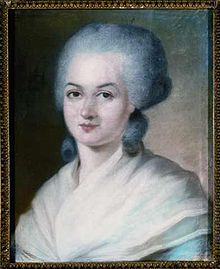 On this day in 1793, playwright, abolitionist, and feminist Olympe de Gouges mounted a Paris scaffold to the guillotine, at the age of 45. Born Marie Gouze on 7 May 1748 in Montauban, Quercy (in the present-day department of Tarn-et-Garonne), in southwestern France. She began her career as a playwright in the early 1780s. As political tension rose in France, de Gouges began writing political pamphlets. She became an outspoken advocate for improving the condition of slaves in the colonies of 1788. Perhaps best known as an early feminist who demanded that French women be given the same rights as French men. In her Declaration of the Rights of Woman and the Female Citizen (1791), she challenged the practice of male authority and the notion of male–female inequality. She wrote; “Si la femme a le droit de monter sur l’échafaud, elle doit avoir également celui de monter à la tribune.” (A woman has the right to be guillotined; she should also have the right to debate.) She was executed by guillotine during the Reign of Terror for attacking the regime of the Revolutionary government and for her close relation with the Girondists.
On this day in 1793, playwright, abolitionist, and feminist Olympe de Gouges mounted a Paris scaffold to the guillotine, at the age of 45. Born Marie Gouze on 7 May 1748 in Montauban, Quercy (in the present-day department of Tarn-et-Garonne), in southwestern France. She began her career as a playwright in the early 1780s. As political tension rose in France, de Gouges began writing political pamphlets. She became an outspoken advocate for improving the condition of slaves in the colonies of 1788. Perhaps best known as an early feminist who demanded that French women be given the same rights as French men. In her Declaration of the Rights of Woman and the Female Citizen (1791), she challenged the practice of male authority and the notion of male–female inequality. She wrote; “Si la femme a le droit de monter sur l’échafaud, elle doit avoir également celui de monter à la tribune.” (A woman has the right to be guillotined; she should also have the right to debate.) She was executed by guillotine during the Reign of Terror for attacking the regime of the Revolutionary government and for her close relation with the Girondists.
 The Final Footprint – De Gouges was interred in a communal grave in the Madeleine Cemetery, a former cemetery in the 8th arrondissement of Paris, one of the four cemeteries (the others being Errancis Cemetery, Picpus Cemetery and the Cemetery of Saint Margaret) used to dispose of the corpses of guillotine victims during the French Revolution. In 1844, the cemetery was cleared and the skeletal remains were transferred to the l’Ossuaire de l’Ouest (West Ossuary). When the ossuary was closed, the contents were transferred to the Paris catacombs (Catacombes de Paris), an underground ossuary in Paris which hold the remains of more than six million people located in a part of a tunnel network built to consolidate Paris’ ancient stone mines. Extending south from the Barrière d’Enfer (“Gate of Hell”) former city gate, this ossuary was created as part of the effort to eliminate the city’s overflowing cemeteries. Preparation work began not long after a series of basement wall collapses at Saint Innocents cemetery. Beginning in 1786, nightly processions of covered wagons transferred remains from most of Paris’ cemeteries to a mine shaft opened near the Rue de la Tombe-Issoire.
The Final Footprint – De Gouges was interred in a communal grave in the Madeleine Cemetery, a former cemetery in the 8th arrondissement of Paris, one of the four cemeteries (the others being Errancis Cemetery, Picpus Cemetery and the Cemetery of Saint Margaret) used to dispose of the corpses of guillotine victims during the French Revolution. In 1844, the cemetery was cleared and the skeletal remains were transferred to the l’Ossuaire de l’Ouest (West Ossuary). When the ossuary was closed, the contents were transferred to the Paris catacombs (Catacombes de Paris), an underground ossuary in Paris which hold the remains of more than six million people located in a part of a tunnel network built to consolidate Paris’ ancient stone mines. Extending south from the Barrière d’Enfer (“Gate of Hell”) former city gate, this ossuary was created as part of the effort to eliminate the city’s overflowing cemeteries. Preparation work began not long after a series of basement wall collapses at Saint Innocents cemetery. Beginning in 1786, nightly processions of covered wagons transferred remains from most of Paris’ cemeteries to a mine shaft opened near the Rue de la Tombe-Issoire.
The ossuary remained largely forgotten until it became a novelty-place for concerts and other private events in the early 19th century; after further renovations and the construction of accesses around Place Denfert-Rochereau, it was open to public visitation from 1874. Since January 1 2013, the Catacombs number among the 14 City of Paris Museums managed by Paris Musées. Although the ossuary comprises only a small section of the underground “carrières de Paris” (“quarries of Paris”), Parisians presently often refer to the entire tunnel network as “the catacombs”.
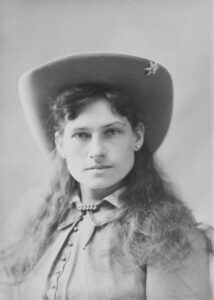 On this day in 1926 sharpshooter who starred in Buffalo Bill’s Wild West show Annie Oakley died of pernicious anemia in Greenville, Ohio, at the age of 66. Born Phoebe Ann (Annie) Mosey on August 13, 1860, in a log cabin less than two miles (3.2 km) northwest of Woodland, now Willowdell, in Darke County, Ohio.
On this day in 1926 sharpshooter who starred in Buffalo Bill’s Wild West show Annie Oakley died of pernicious anemia in Greenville, Ohio, at the age of 66. Born Phoebe Ann (Annie) Mosey on August 13, 1860, in a log cabin less than two miles (3.2 km) northwest of Woodland, now Willowdell, in Darke County, Ohio.
Oakley developed hunting skills as a child to provide for her impoverished family in western Ohio. At 15, she won a shooting contest against experienced marksman Frank E. Butler, whom she later married in 1876. The pair joined Buffalo Bill in 1885, performing in Europe before royalty and other heads of state. Audiences were astounded to see her shooting out a cigar from her husband’s lips or splitting a playing-card edge-on at 30 paces. She earned more than anyone except Buffalo Bill himself.
After a bad rail accident in 1901, she had to settle for a less taxing routine, and toured in a play written about her career. She also instructed women in marksmanship, believing strongly in female self-defense. Her stage acts were filmed for one of Thomas Edison’s earliest Kinetoscopes in 1894.
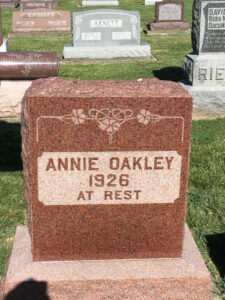 The Final Footprint – Cremated remains interred at Brock Cemetery, near Greenville. A collection of Oakley’s personal possessions, performance memorabilia, and firearms are on permanent exhibit in the Garst Museum and the National Annie Oakley Center in Greenville, Ohio. She has been inducted into the Trapshooting Hall of Fame, the National Cowgirl Museum and Hall of Fame in Fort Worth, Texas, the National Women’s Hall of Fame, the Ohio Women’s Hall of Fame, and the New Jersey Hall of Fame. Her story has been adapted for stage musicals and films, including Annie Get Your Gun, musical with lyrics and music by Irving Berlin and a book by Dorothy Fields and her brother Herbert Fields.
The Final Footprint – Cremated remains interred at Brock Cemetery, near Greenville. A collection of Oakley’s personal possessions, performance memorabilia, and firearms are on permanent exhibit in the Garst Museum and the National Annie Oakley Center in Greenville, Ohio. She has been inducted into the Trapshooting Hall of Fame, the National Cowgirl Museum and Hall of Fame in Fort Worth, Texas, the National Women’s Hall of Fame, the Ohio Women’s Hall of Fame, and the New Jersey Hall of Fame. Her story has been adapted for stage musicals and films, including Annie Get Your Gun, musical with lyrics and music by Irving Berlin and a book by Dorothy Fields and her brother Herbert Fields.
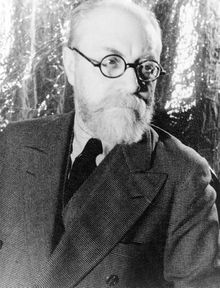 On this day in 1954, artist, painter, sculptor Henri Matisse died in Nice, Alpes-Maritimes, France at the age of 84. Born Henri-Émile-Benoît Matisse on 13 December 1869 in Le Cateau-Cambrésis, Nord, France. In my opinion, along with with Picasso and Marcel Duchamp, Matisse is one of the leading figures of modern art.
On this day in 1954, artist, painter, sculptor Henri Matisse died in Nice, Alpes-Maritimes, France at the age of 84. Born Henri-Émile-Benoît Matisse on 13 December 1869 in Le Cateau-Cambrésis, Nord, France. In my opinion, along with with Picasso and Marcel Duchamp, Matisse is one of the leading figures of modern art.
The intense colorism of the works he painted between 1900 and 1905 brought him notoriety as one of the Fauves (wild beasts). Many of his finest works were created in the decade or so after 1906, when he developed a rigorous style that emphasized flattened forms and decorative pattern. In 1917, he relocated to a suburb of Nice on the French Riviera, and the more relaxed style of his work during the 1920s gained him critical acclaim as an upholder of the classical tradition in French painting. After 1930, he adopted a bolder simplification of form. When ill health in his final years prevented him from painting, he created an important body of work in the medium of cut paper collage.
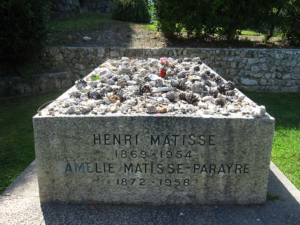 The Final Footprint – Matisse is interred with his wife Noellie Matisse-Parayre in the cemetery of the Monastère Notre Dame de Cimiez, near Nice. Their graves are marked by a large marble upright monument.
The Final Footprint – Matisse is interred with his wife Noellie Matisse-Parayre in the cemetery of the Monastère Notre Dame de Cimiez, near Nice. Their graves are marked by a large marble upright monument.
Selected Gallery of Paintings
 Luxe, Calme et Volupté, 1904, Musée National d’Art Moderne. |
 Portrait of Madame Matisse (The green line), 1905, Statens Museum for Kunst, Copenhagen, Denmark |
||
 The Young Sailor II, 1906, Metropolitan Museum of Art, New York City |
 Blue Nude (Souvenir de Biskra), 1907, Baltimore Museum of Art |
 Madras Rouge, 1907 Barnes Foundation
|
 On this day in 1990, actress and singer, Mary Martin died of cancer four weeks before her 77th birthday at her home in Rancho Mirage, California. Born Mary Virginia Martin in Weatherford, Texas on 1 December 1913.
On this day in 1990, actress and singer, Mary Martin died of cancer four weeks before her 77th birthday at her home in Rancho Mirage, California. Born Mary Virginia Martin in Weatherford, Texas on 1 December 1913.
A muse of Rodgers and Hammerstein, she originated many leading roles on stage over her career, including Nellie Forbush in South Pacific (1949), the title character in Peter Pan (1954), and Maria von Trapp in The Sound of Music (1959). She was the mother of actor Larry Hagman.
Martin was inducted into the American Theater Hall of Fame in 1973. She received the Kennedy Center Honors, an annual honor for career achievements, in 1989. She received the Donaldson Award in 1943 for One Touch of Venus. A Special Tony Award was presented to her in 1948 while she appeared in the national touring company of Annie Get Your Gun for “spreading theatre to the rest of the country while the originals perform in New York.” In 1955 and 1956, she received, first, a Tony Award for Peter Pan, and then an Emmy for appearing in the same role on television. She also received Tonys for South Pacific and in 1959 for The Sound of Music.
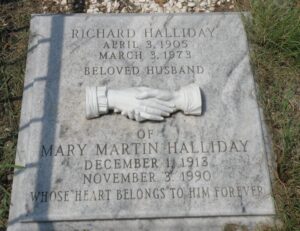 The Final Footprint – She is buried in City Greenwood Cemetery in Weatherford, Texas.
The Final Footprint – She is buried in City Greenwood Cemetery in Weatherford, Texas.
 And on this day in 2018, actress and director, Sondra Locke died at her Los Angeles home from cardiac arrest related to breast and bone cancer at the age of 74. Born Sandra Louise Smith on May 28, 1944 in Shelbyville, Tennessee.
And on this day in 2018, actress and director, Sondra Locke died at her Los Angeles home from cardiac arrest related to breast and bone cancer at the age of 74. Born Sandra Louise Smith on May 28, 1944 in Shelbyville, Tennessee.
She achieved worldwide recognition for her relationship with Clint Eastwood and the six hit films they made together.
An alumna of Middle Tennessee State University, Locke broke into regional show business with assorted posts at the Nashville-based radio station WSM-AM, then progressed to television as a promotions assistant for WSM-TV. In 1968, she made her film debut in The Heart Is a Lonely Hunter, for which she was nominated for an Academy Award for Best Supporting Actress. Locke went on to appear in such box office successes as Willard (1971), The Outlaw Josey Wales (1976), The Gauntlet (1977), Every Which Way but Loose (1978), Bronco Billy (1980), Any Which Way You Can (1980) and Sudden Impact (1983). She worked regularly with Eastwood, who was her companion for 14 years despite their marriages to other people. She also directed four films, notably Impulse (1990), and published an autobiography, The Good, the Bad, and the Very Ugly: A Hollywood Journey (1997).
Locke’s persona belied her age, and she habitually played roles written for women much younger than herself. She claimed to have been born several years later than 1944, and her true age remained a secret throughout her career.
Locke is remembered as an early pioneer for women in Hollywood. She was one of 11 female filmmakers in 1990, the year WB released her sophomore feature, Impulse. By the time of Trading Favors (1997), her fourth effort, still only eight percent of all films were made by women, per the Directors Guild of America.
Locke’s influence as a feminist icon was duly acknowledged by the mainstream press. In 1989, Claudia Puig of the Los Angeles Times described her lawsuit against Clint Eastwood as a “precedent-setting legal case, as it raises the question of whether a woman, who is legally married to one man, can claim palimony rights from another.” Childfree by choice – unusual for a person of her generation – Locke was among the first celebrities to publicly discuss her abortion experiences. The avowal made Locke “a talking-point in America’s sexual politics debate,” according to The Guardian’s Peter Bradshaw. Locke’s subsequent relationship with a doctor young enough to be her son added to her notoriety.
Cinematographer David Worth credits her with his big break. She is admired by such actresses as Frances Fisher and Rosanna Arquette, who applauded the strength of her directorial accomplishments, however short-lived.
During the last third of her life, Locke maintained she was blacklisted from the film industry as a result of her acrimonious split from Eastwood; his career went forward unscathed. Peggy Garrity, Locke’s former counsel, recalled the courtroom drama in her book In the Game: The Highs and Lows of a Trailblazing Trial Lawyer (2016). Garrity revealed that Locke’s 1999 confidential settlement from WB “was for many millions more than the settlement with Clint had been.” Locke v. Warner Bros. Inc also catalyzed changes within the legal system. In a landmark decision, California’s Supreme Court ruled that access to civil trials could no longer be closed off to the public.
The Final Footprint – Her remains were cremated on November 9 at Pierce Brothers Westwood Village Memorial Park and Mortuary and the ashes were given to her widower, Gordon Anderson.
Numerous outlets faced pushback over their chosen headlines for Locke’s obituary. Several major publications prefaced news of her death by tagging Eastwood’s name atop the article, which received criticism by some who deemed it a sexist epitaph, with fans on social media pointing out that Locke was an Oscar nominee prior to meeting Eastwood. Women’s blog Jezebel criticized The Hollywood Reporter for ostensibly regarding Locke as a nonentity; THR subsequently changed its headline. News organization TheWrap – whose editor, Sharon Waxman, reviewed Locke’s memoir for The Washington Post in 1997 – opined that her story “should stir resonance in this age of the #MeToo movement.” In a tribute to the late actress, author Sarah Weinman wrote: “Sondra Locke, like Barbara Loden, deserves to be known for her work, not for the famous man she was disastrously involved with.”
Have you planned yours yet?
Follow TFF on twitter @RIPTFF



